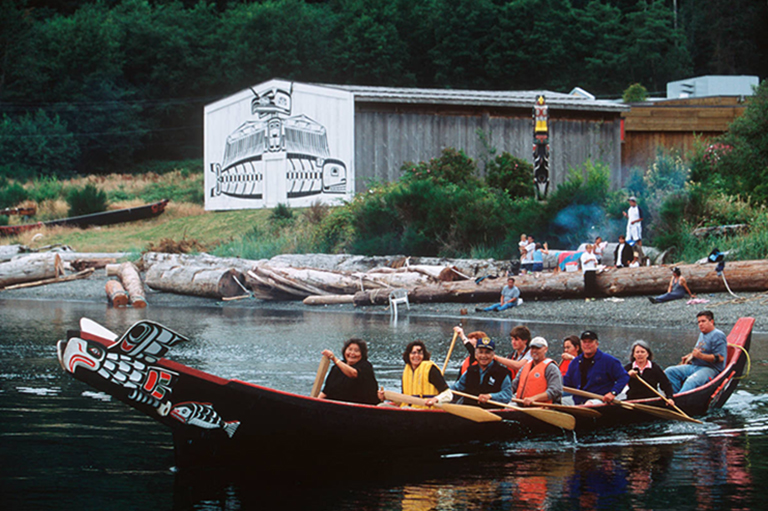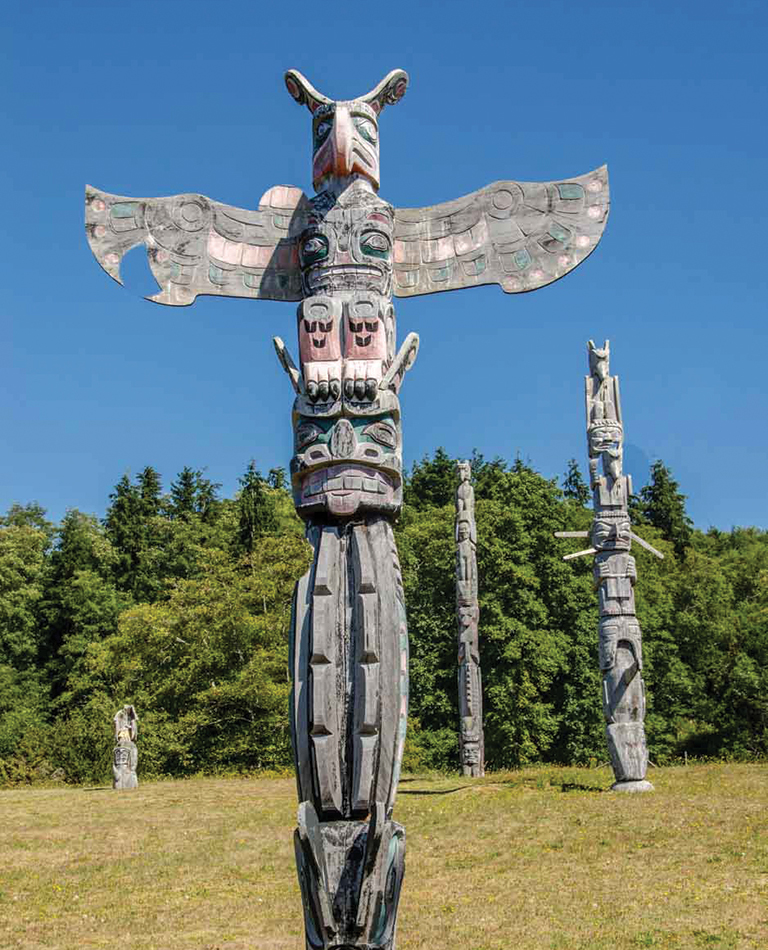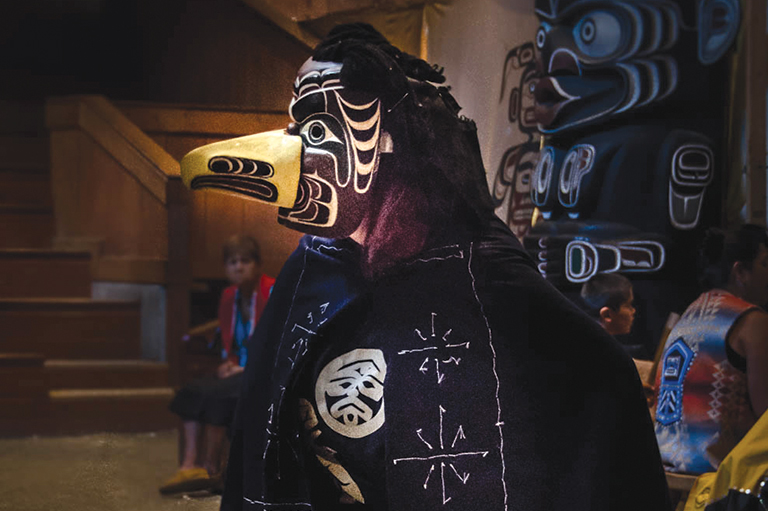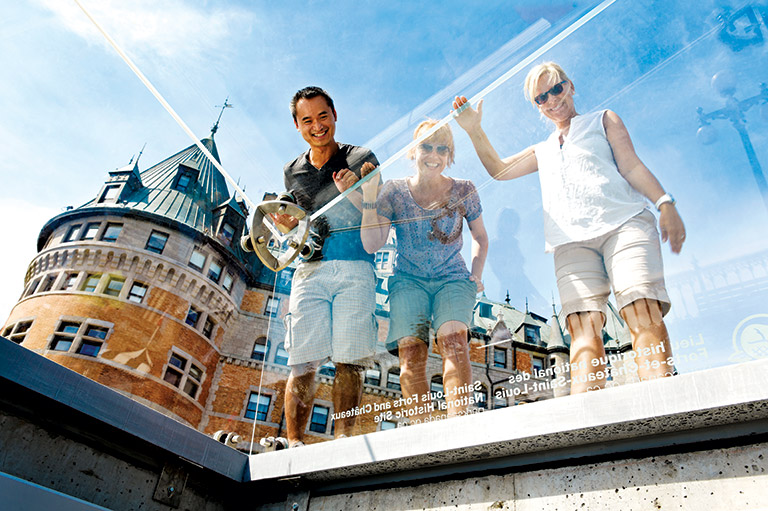Culture Reclaimed, Culture Shared

It’s surprising how powerful an empty space can be. I’m standing in front of an unremarkable rectangle of gravel and scrubby weeds in Alert Bay on British Columbia’s Cormorant Island.
It’s the site of a former residential school that was torn down in 2015, with many who survived it throwing stones and lighting candles as the edifice tumbled into history.
Where a four-storey red-brick facade once dominated the view, there is now just that rectangle and a plaque that explains it.
As I pause to reflect on the cruelty of separating First Nations children from their families and bringing them to this small island off the north coast of Vancouver Island, my eye now lights on towering totem poles and, on the hill above me, the striking ’Namgis Traditional Big House with its graceful lines and traditional Kwakwa-ka-’wakw art. The gravel and weeds are utterly insignificant. And that makes me smile.
I had started my day in Alert Bay with a short walk from the ferry dock to the tourist information centre, where the terrific staff provided information-packed brochures and maps. (The publications are also available on the village’s website.)
A little farther along is the ’Namgis burial grounds, where cedar totem poles mark many gravesites. Staying on the sidewalk, as requested to show respect, I learn that when these poles topple many families leave them where they fall, to return to the earth.

The mist that made the early ferry ride from neighbouring Malcolm Island both chilly and mysterious has given way to full-on sun, and I’m getting hungry.
Unfortunately, I can’t seem to find the glowingly reviewed Duchess’ Bannock & Desserts; it just isn’t where my paper or electronic maps show it.
I reluctantly wander back northwest through the village of about five hundred; there are perhaps fifteen hundred residents on the island. The boardwalk along the shore has five roofed lookouts, called awakwas, each with a breathtaking painted carving overhead that represents a ’Namgis ancestor.
It’s a beautiful walk, and my sister and my niece are coming on a later ferry, so I take my time, stopping to pick up coffee and to admire the high-quality jewellery at the First Nations-owned Culture Shock gallery and gift shop.
A little farther along, a plaque explains the history of the ’Namgis First Nation net loft, a long shed supported by poles that extends out over the water. Local fishers have mended and dried their nets here for generations.
My first sight of the U’mista Cultural Centre is its glorious collection of totem poles. Inside, there are several excellent permanent and temporary displays related to Kwakwa-ka-’wakw art, history, origin stories, and more. But the heart of the centre is its collection of stunning carved masks as well as dance aprons (tseps), rattles, and other regalia.
The quietness of the spacious exhibition area prompts awe at the survival of a culture the government tried so hard to snuff out with its ban on the traditional potlatch. The ban lasted from 1885 to 1951, but it couldn’t destroy the people or their ceremony, which proudly persist today.
When I meet my sister Valerie and niece Esmé as they come off the ferry, we’re in luck. Duchess’ Bannock & Desserts, which turns out to be some portable kitchen equipment and folding tables under tents, is now set up. We order bannock hot dogs — delicious — and bannock with berries and whipped cream — even more delicious.
We walk up the hill to the big house for a demonstration of traditional dance and drumming by the T’sasała Dance Group. Craning our necks we gaze up at the world’s tallest totem pole, which extends upwards nearly fifty-three metres.

We leave the sunshine behind as we enter the dimly lit Big House, or Gukwdzi, which has wooden bleachers on both sides of a large dirt performing area surrounding a smoky firepit.
The seating for drummers at the far end is flanked by totem poles. Before the performance starts, members of the group chat with spectators, welcoming us to their territory and encouraging us to take photos.
Dozens of dancers ranging from tiny children to dignified elders take part in the afternoon’s event, embodying generations of history and culture as they move with the powerful drumbeats.
Sometimes wearing carved masks, sometimes in regalia, they depict ancient stories for a modern audience that’s come from all over the world. The performance ends with the peace dance. We are all invited to participate, and it’s a beautiful and humbling experience, given all that we who are not of this culture have to answer for.
There’s a lot to think about as we sail away, ending our day as guests on Cormorant Island.
At Canada’s History, we highlight our nation’s past by telling stories that illuminate the people, places, and events that unite us as Canadians, while understanding that diverse past experiences can shape multiple perceptions of our history.
Canada’s History is a registered charity. Generous contributions from readers like you help us explore and celebrate Canada’s diverse stories and make them accessible to all through our free online content.
Please donate to Canada’s History today. Thank you!
Themes associated with this article
Advertisement




